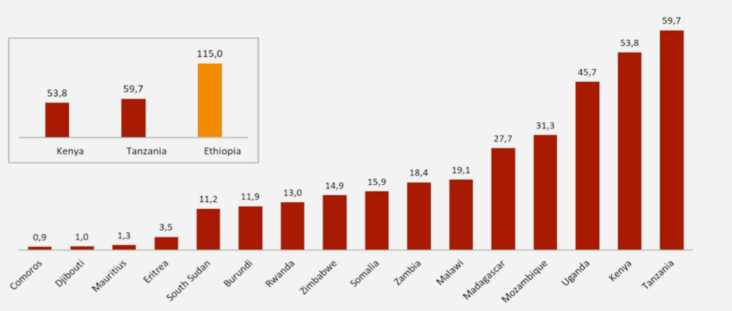‘Why Africa?’ – Dubai Chamber Highlights Major Strengths And Opportunities In East Africa

Africa’s most populous region with nearly 456 million inhabitants, East Africa was also the continent’s fastest growing district between 2015 and 2020 with a cumulative annual growth rate (CAGR) of about 4.3%, revealed a new report by the Dubai Chamber of Commerce and Industry.
Focusing on East Africa, the report is the latest instalment of the Chamber’s‘Why Africa?’ initiative, which explores and analyses key economic indicators in the continent, going region by region. The initiative is a precursor to the Global Business Forum (GBF) Africa 2021, which takes place on October 13-14 on the sidelines of Expo 2020 Dubai.
“Dubai has made great progress in its efforts to expand commercial, economic, and cultural ties with African, guided by our leadership’s directives, which not only build on our historic relationship with the continent, but also bet on Africa’s potential as one of the world’s most promising regions,” said H.E. Hamad Buamim, President and CEO of Dubai Chamber.“We pave the way for Dubai’s business community to enter into African markets, offering them reliable insight into the continent with in-depth studies, most notably, the series of region-specific reports issued under our flagship ‘Why Africa?’ initiative.”
East Africa comprises 18 countries: Burundi, Comoros, Djibouti, Ethiopia, Eritrea, Kenya, Madagascar, Malawi, Mauritius, Mozambique, Rwanda, Seychelles, Somalia, South Sudan, Tanzania, Uganda, Zambia, and Zimbabwe.
In terms of real GDP, East Africa ranked as the continent’s third-largest region, accounting for 15% of Africa’s GDP with an average value of USD355.1bn. Ethiopia is the region’s largest economy, accounting for 22.7% of its total real GDP in 2020. Kenya comes in second with a 20.5% share, followed by Tanzania with 17.5%. Ethiopia and Tanzania also top the list of fastest growing economies in the region in terms of real GDP, with a 6.9% CAGR in2015-2020.
Looking at per capita GDP paints a different picture of the region, where the top three for 2020 become the smaller nations of Seychelles, with a per capita GDP of USD13,900, followed by Mauritius with USD9,500, and Djibouti with USD3,200.
Foreign Direct Investment (FDI) is another prominent indicator of economic performance and in 2020, East Africa was third on the continent in terms of share of FDIs, accounting for 17.1% of Africa’s USD167.8bntotal inward FDI stocks. Nevertheless, East Africa saw its inward FDI stocks increase by 9.1% in 2015-2020, highlighting the region’s sustained attractiveness to foreign investors.
Mozambique is the top FDI destination in East Africa, with total FDI stocks of USD45.4bn in 2020 – nearly 26% of the region’s total FDI inward stocks.Other major destinations were Ethiopia with a 16% share and Zambia with 12%.
East Africa-Dubai bilateral trade figures reveal that the region’s share of Dubai total trade grew considerably over the years. In 2020, it was the emirate’s third largest trading partner in Africa, with total trade value hitting USD12.2bn – a 24.4% share of Dubai’s trade with Africa.
Dubai’s trade with East Africa is relatively balanced. Imports accounted for 43% of trade activity, while re-exports and exports made up 42% and 15% in 2015-2020. Imports grew 22% in the same period, while exports grew 15%, and re-exports 3%.
Jewellery and precious stones accounted for about 85% of Dubai imports from the region in 2015-2020, worth USD5.6bn in 2020 alone. Uganda and Zimbabwe accounted for the bulk of that value, making up 28% and 23% of the total, respectively.Excluding this category, the emirate’s total imports in 2020 were valued at USD412.2m, 41% of which came from Kenya, with Zimbabwe, Tanzania, and Ethiopia following with 15%, 10%, and 9%.
In 2020, Dubai’s total re-exports to East Africa were valued at USD3.9bn,with leading products being electrical machinery, mineral fuels, vehicles, and digital automatic data processing machines. They went primarily to Kenya (24.2%), Tanzania (14.2%), and Djibouti (13.1%). Meanwhile, Dubai’s 2020 exports to the region totalled USD1.97bn, chiefly, manufactured tobacco, mineral fuels, pearls and precious stones, and plastics. Dubai’s major export markets in Eastern Africa in 2020, were Somalia (36.8%), Kenya (23.6%), and Djibouti (8.9%).
To view the report, please click here


